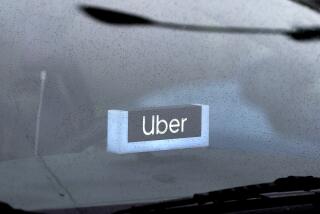YOUR TAXES : PART FOUR: SPECIAL SITUATIONS : It’s getting harder to be your own boss : Tax Reform Act tightens the rules for claiming self-employed status
- Share via
Most Americans know the answer to the seemingly simple question: Are they employees of a company or self-employed?
But with the passage of the new tax law, millions of taxpayers may be in doubt about their status, even though the answer can have a significant impact on their income and on the amount of taxes they pay. The new rules affect an estimated 250,000 Californians and hundreds of thousands of others around the country, although no one knows exactly how many. And there are millions of people who consider themselves self-employed and may be affected by future changes in the law.
Until recently, things were fairly simple: The Internal Revenue Service didn’t pay much attention to the self-employment issue, and taxpayers could pretty much pick the category they preferred.
There were “common law” definitions that seemed straightforward enough. If you were “subject to the will and control of an employer as to what must be done and how it must be done,” then you were an employee.
If you worked at your own pace, got your own jobs, didn’t work in an office and were responsible for your productivity, you could be called self-employed.
But it was all loosely administered, and few were challenged about their status by the IRS, although the IRS realized that millions of dollars in tax revenue was being lost because taxpayers who were really employees of a company were improperly listing themselves as self-employed.
There was some tinkering with a few job categories such as trucking and real estate sales in the early 1980s, but it wasn’t until the great debates over the Tax Reform Act of 1986 that anything firm was accomplished.
Sen. Daniel P. Moynihan (D-N.Y.) and others in Congress were looking desperately for new revenue-raising measures that would not look like a tax increase. Moynihan got enough support to include a clearer distinction between employee and self-employed, but it was not a sweeping solution.
It did, however, pretty firmly separate the two categories for computer programmers, systems analysts, designers, engineers, draftsmen and many others who fitted into a “technical service specialist” category. (For the rules that define self-employed and employee status, see the accompanying box.)
Technical service specialists had for years been able to file their tax returns as independent consultants or contractors. In other words, they were considered by the IRS to be self-employed under the “Safe Haven” provision enacted by Congress in 1978, and few were challenged. The Safe Haven rule stated that most taxpayers who had been listing themselves as self-employed could continue to do so. Also, new employees moving into jobs that traditionally had been considered self-employment would get the protection of the safe haven.
The new tax law substantially reduces the size of the safe haven.
It is no longer open almost automatically to any high-tech specialist who wants to use it. This is going to put many of the specialists into the “employee” category, and most of them fear, apparently with justification, that they will have to pay additional taxes when they file their 1987 returns next year.
There are several reasons why some taxpayers want to be called self-employed. For instance, while they pay income taxes, federal tax money is not withheld from their paychecks. The new law means that withholding taxes will be deducted, disrupting their cash flow.
Also, employees pay for disability insurance. In California that is 1.2% of gross income, and it is comparable in most other states. The self-employed don’t have such insurance, so its premiums are not deducted from their paychecks.
Companies using consultants pay no unemployment insurance taxes for them, and so they often add at least part of the cost of those taxes to the fees paid to the self-employed.
The self-employed can also invest more money for retirement in a Keogh plan than regular company employees can put aside in an individual retirement account, especially now that the deductibility of IRA contributions has been limited.
Perhaps the most critical factor favoring the self-employed is their expense account. They could claim as deductions all of their business expenses: cars and car maintenance, home offices, entertainment and other items.
The 1987 expense rules that apply to business generally also apply to the self-employed. The most important change here is that only 80% of meal and entertainment costs are deductible, instead of 100% under the old rules.
Business expenses incurred by employees that are not paid by their employers are limited under the new law. Business expenses, along with other “miscellaneous deductions,” can be written off only to the extent that they exceed 2% of adjusted gross income. For instance, if you have a $40,000 adjusted gross, as an employee you cannot deduct the first $800 of your unreimbursed expenses.
But it’s not all pluses for the self-employed. They don’t always have regular paychecks. They are not paid if they take vacations, holidays or sick leave. They have no unemployment benefits if they run out of work and no automatic disability payments if they are hurt on the job. They have to buy their own health insurance or do without it.
The self-employed can deduct up to about 25% of their health insurance premiums as a business expense. The rest must then be included with other medical expenses, subject to the usual limitation--only expenses that total more than 7.5% of adjusted gross income are deductible.
The self-employed pay more Social Security taxes: It was 12.3% of the first $42,000 of net earnings in 1986, rising to $43,000 this year. In contrast, an employee paid only 7.15% in 1986 on the first $42,000 of net earnings, and for 1987 the figures rises to $43,800. (The employer also pays 7.15%.)
There was a lot of confusion among the self-employed when the Tax Reform Act was passed, so the IRS issued a statement assuring them that the new law does not automatically change their status.
Many high-tech specialists who say they are self-employed get their jobs though brokers or agencies. Some of those firms do no more than recruit the specialists, as they do other temporary workers, and charge those who want such services a fee of about 10% of the worker’s earnings.
This gives the worker nothing but a base salary--no fringe benefits of any kind and rarely any assurance of steady employment. But they have the advantages of being listed as self-employed.
Some firms in the business of providing high-tech temporaries do much more for those who go to them. Amtec, based in Los Angeles, is part of a nationwide company that finds jobs for thousands of high-tech temps. Amtec alone supplies temps to 43 of the Fortune 50 companies.
Joel Brust, president of the corporation, says about 70% of those temps who use Amtec are considered employees of his firm and can get a full range of fringe benefits. The remaining 30% are considered self-employed and will now have to become employees of Amtec.
Some of the 30% who were listed as self-employed worked more than one job in one period of time, some even on the same day. Others worked for one firm for a year or more.
But now, under the new law, all high-tech temporaries who go through a broker or agency are expected to change their status to employee under what the IRS calls the “third-party rule.” A worker who regularly finds jobs through a third party like Amtec is automatically regarded as an employee.
However, some of those agencies are telling their independent consultants not to rush to change their status. The agencies are trying to figure out ways to get around the new law.
But Amtec and some other agencies are not waiting around. Amtec’s new “employees”--those who had been listed as self-employed--are being offered interest-free loans to help them get used to their lower cash flow due to the withholding taxes that will now come out of their paychecks.
In addition to the high-tech self-employed, there are vast numbers of others who--as of now, at least--are still in reasonably safe havens.
For instance, real estate sales people are treated as self-employed if they are licensed and substantially all of their income is directly related to sales or other output rather than to the number of hours worked. (This must be spelled out in a written contract.)
Similarly, “direct sellers,” such as those who sell Tupperware and Avon products door to door, continue to be counted as self-employed if they get paid by commissions rather than by hours worked.
Independent truckers who prefer being listed as self-employed are also still “safe” from the employee status as long as no one challenges them. Then they, too, will have to prove that they are self-employed according to basic IRS guidelines.
More to Read
Inside the business of entertainment
The Wide Shot brings you news, analysis and insights on everything from streaming wars to production — and what it all means for the future.
You may occasionally receive promotional content from the Los Angeles Times.










